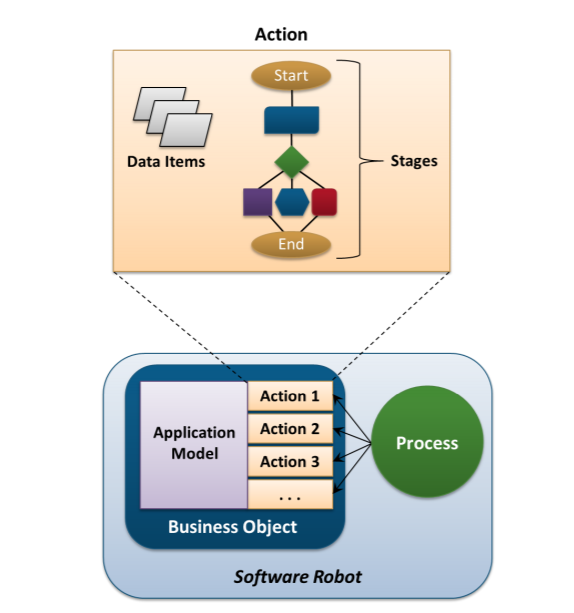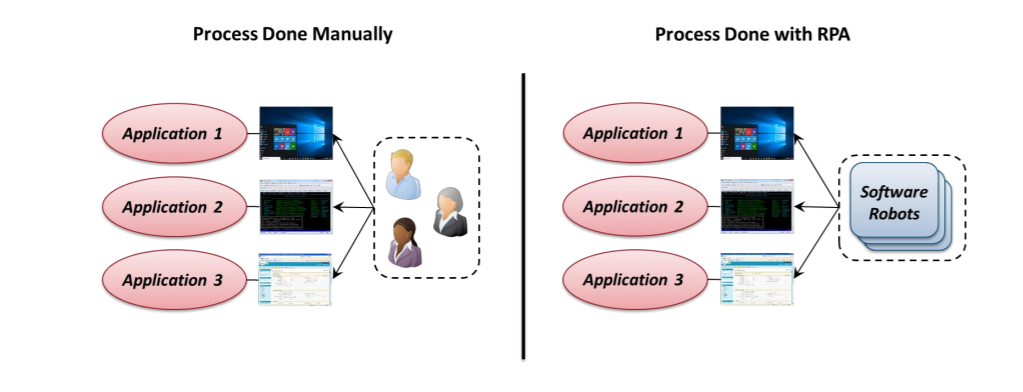本文转自:https://www.rpatraining.co.in/blue-prism-interview-questions/
What is a Visual Business Object?
The role of a VBO is to act as an adapter to the user interface of a specific application. To accomplish this,each VBO has three main parts:
- A connector, which is a standard library provided by Blue Prism for communicating with a
particular kind of application user interface. - An application control interface (ACI) that uses the VBO’s connector to expose the elements of a
specific application’s user interface. - One or more pages, each of which implements all or part of an operation that the VBO can
perform.
How to create an action in blueprism and how can it be published ?
As their name suggests, actions implement the logic of a business object. As Figure 6 shows, each action contains a set of stages along with data items holding information used by that action.
An action can be published, which lets it be called by processes and potentially other software. An action can also remain private, making it available only to other actions in this business object. Whichever option is chosen, the action begins with a Start stage and finishes with an End stage, as as below image shows.In between appear whatever stages are required to carry out the tasks this action performs.
 .
.What are the commonly used stages in VBO
- Read: gets data from a user interface element and stores it in a data item.
- Write: puts data from a data item to a user interface element.
- Navigate: opens menus, clicks buttons, and carries out other tasks required to navigate through
an application’s screens. - Wait: pauses execution until a condition is met in the application. For example, a VBO might
need to wait until a particular window has appeared before proceeding or wait for the entire
application to finish loading. - Link: creates a link between stages in a page’s operation.
- Decision: acts like an If statement, branching an operation’s control flow based on the value of
one or more data items. - Choice: acts like a switch statement, selecting one of several control flow options based on the
value of one or more data items. - Calculation: contains an expression that performs a calculation on data items, such as adding two
numbers, extracting a sub-string, or converting a date from one format to another. - Loop: iterates through a collection of data.
- Code: contains arbitrary code written in languages such as C# and Visual Basic. This might be
used to carry out complex data manipulation, for example, or to access an application-specific
interface, such as a COM object in a Windows interface. Code stages can also be used to access
database interfaces, giving a page direct access to application data. - Page: invokes another page in this VBO.
- Exception: explicitly raises an exception in the execution of an operation.
- Recovery: begins a block for handling exceptions.
- Resume: ends a block for handling exceptions.
- Alert: sends a notification to one or more subscribers via email indicating that something has
occurred. A VBO might send an alert whenever an exception is raised, for example.
What is a Blue Prism Process?
Since Blue Prism accesses applications through their user interfaces, a Blue Prism process acts much like a human user. Just as a person might interact with several applications to carry out a series of business steps, a Blue Prism process can invoke operations in several VBOs to carry out those same steps.
In some ways, a Blue Prism process is quite similar to a VBO. Like a VBO, a process is defined in one or more pages, and each page contains some number of stages and data items. There are important differences, however. The biggest one is the way in which pages can be invoked. In a VBO, any published page can be called at any time; the object exposes a set of operations that can be invoked in any order. A Blue Prism process, however, always begins at its Main page, and the pages it contains always execute in a defined order
How to create a Process in Blueprism and how does it work ?
To create a process, a business analyst or developer uses Process Studio. Just as processes are similar to business objects, Process Studio is similar to Object Studio
A process defined in Process Studio looks much like a traditional flowchart. As in Object Studio, each page in a process has its own tab, letting the analyst divide the process into logical groupings. Also like Object Studio, Process Studio allows its user to create logic graphically by assembling stages on a design surface. The tool includes a built-in debugger that allows stepping through a process, setting breakpoints, examining data items, and more.
One of the challenges in working with business processes is changing them safely. To help with this, Process Studio keeps track of the previous version of a process being edited. The user of the tool is then able to switch to a view that shows both the old and new versions side-by-side, letting her see exactly what’s different. Blue Prism also provides a process history tool that allows tracking revisions to processes over time.
How to deploy blue prism applications ?
Just like manual processes, automated processes need to be controlled and managed. To allow this, Blue
Prism provides two tools: Control Room and System Manager.
The purpose of Control Room is to let both business analysts and IT staff work with Blue Prism processes.
The tool lets them perform tasks such as:
- Starting and stopping instances of Blue Prism processes. (It’s also possible to do this from the
command line or with external software—using Control Room isn’t required. - Viewing the log produced by each Blue Prism process, either while the process is running or after
it’s completed. Among other things, this log records when each stage in a process is executed. - Creating process schedules. For example, a business analyst might define a schedule that runs
Blue Prism process X at 9 am every Friday morning. If X completes successfully, the schedule then runs Blue Prism process Y. If X doesn’t complete successfully, the schedule runs Blue Prism
process Z. - Viewing workqueues, examining things such as how far Blue Prism processes have gotten in a
particular input file and what exceptions have occurred.
How to secure blue prism applications ?
Any application intended for enterprise deployment must squarely address security, and Blue Prism is no
exception. One important foundation for security in the product is role-based access control. Once a Blue
Prism administrator has defined what roles a user can act in, the system will allow that user to perform
only the actions allowed by these roles.
Blue Prism also keeps track of significant changes to its environment. Using the Audit Log Viewer, part of
System Manager, an administrator can examine records of things such as when a user logs into Blue
Prism, when that user starts or deletes a process, when that user changes her password, and more.
Another issue, especially for a technology based on presentation integration, is safely storing and
managing the user names and passwords used to log in to applications. To do this, Blue Prism provides an
encrypted credentials database controlled by a Blue Prism administrator. For example, a set of credentials
(i.e., a user name and password) might be usable only by specific Blue Prism processes started by users in
specific roles and running on specific servers. It’s also possible to use Active Directory in place of some
parts of Blue Prism’s user management mechanisms. While it’s not required, larger organizations in
particular can find this useful.
How to choose a connector in blue prism ?
The connector’s job is to handle low-level interaction with an application’s user interface. Since
application interfaces use a variety of technologies, Blue Prism provides a variety of connector choices.
The options are:
- An HTML connector, which allows working with HTML, JavaScript, ActiveX controls, and other
common components of a browser interface. - A Windows connector, allowing access to Windows applications built using the .NET Framework,
the Microsoft Foundation Class (MFC) library, Visual Basic 6, PowerBuilder, and other Windowsbased
user interface technologies. - A Java connector for working with user interfaces created using Swing, Java applets, Oracle
Forms, and other technologies based on the Java Virtual Machine. - A mainframe connector, which allows access to mainframe applications through terminal
emulators from various vendors, including Attachmate, Micro Focus, IBM, and others. - A Citrix connector, allowing access to applications that provide their user interfaces via
technologies such as Citrix XenApp and Microsoft Remote Desktop Services.
What is Robotic Process Automation?

As the figure shows, RPA allows replacing people with software robots. While this kind of automation can be useful when a process uses just one application, it’s especially valuable when a process relies on multiple applications, as in the example shown here. Rather than integrating the applications through whatever application programming interfaces (APIs) they might expose, RPA instead accesses each one through its user interface, just as a person would.
What Are The Differences Between Blue Prism And Uipath?
UiPath and Blue Prism both the tools have their respective software/Studio and they are very good. UI and BP both have visual process designers for developing the solutions.
Differences:
In terms of programming languages:
- Blue Prism Uses C# for coding
- UiPath uses VB for coding
In terms of Control Room/Dashboard
- UiPath control room – The Orchestrator – is web based, you can access it from the browser or mobile.
- BP have client based servers, accessible only through their apps.
In terms of cost and uses:
UiPath:
- Lower cost of development
- Easier to learn and operate
- You can learn by your self
- Study materials are easily available on internet
Blue Prism:
- Good for mass scale deployment of large number of robots
- Higher cost of acquiring and using BP
- Limited training available as the only source of training is BP
- Training cost of Blue Prism is too high
